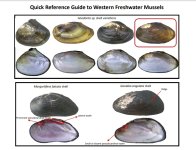Mark Melton
Life of the Party

The strange, savage life of a freshwater mussel
Oh, you think mussels are basically rocks? I’m afraid you are very wrong.
 www.vox.com
www.vox.com

 www.vox.com
www.vox.com
Thanks for including the pdf. It contained a lot of information not included in the article I cited. Living approximately100 years surprised me.I find these critters fascinating, too. Globally, North America is a hotbed for freshwater mussel species richness but here in the Western US we missed out on that with only the pearlshell, western ridged and floaters, the latter of which the taxonomists are having fun with debating splitting and lumping.
@SilverFly we don’t know a ton about what triggers the populations of mussels to sync up their reproduction, but I’m not sure if the timing explains what you’re seeing on (adult?) steelhead in the fall. Get a microscope next time to check it out! The glochidia just look like teensy tiny mussels. http://xerces.org/sites/default/files/publications/10-030.pdf
Yeah with the long lived Margs there can actually be populations of only old individuals that have not successfully reproduced for whatever reasons for years or decades. Folks have used freshly collected specimens, specimens from historic archives, and from prehistoric middens as environmental tracers of changes to river systems over time!Thanks for including the pdf. It contained a lot of information not included in the article I cited. Living approximately100 years surprised me.
I find these critters fascinating, too. Globally, North America is a hotbed for freshwater mussel species richness but here in the Western US we missed out on that with only the pearlshell, western ridged and floaters, the latter of which the taxonomists are having fun with debating splitting and lumping.
@SilverFly we don’t know a ton about what triggers the populations of mussels to sync up their reproduction, but I’m not sure if the timing explains what you’re seeing on (adult?) steelhead in the fall. Get a microscope next time to check it out! The glochidia just look like teensy tiny mussels. http://xerces.org/sites/default/files/publications/10-030.pdf
Not sure what species we have in SWW rivers but they have a somewhat elongated, and thin shell. More like a small, oval razor than a butter clam.
Haven't been to a couple spots on the Washougal in many years where there were (are?) large mussel beds a few square yards in area. I've never seen any weird "lures" in those beds, but would be interesting to know if those steelhead were duped into becoming hosts. The larvae I remember seeing attached to steelhead gills were fairly large at about 1/4" long.
The pearlshell seem to be most common in the higher energy more gravelly cobbley rivers we frequently like to fly fish. Western Ridged mussels seem to occupy similar habitat but are generally rarer and more commonly found to the east of SW WA. Floaters generally occupy slower habitats with finer sediments, but beds have been found with all three species, and I recently read a report on the Willamette where a predominately pearlshell bed was investigated and they identified a single western ridged out of hundreds of pearlshells.Not sure what species we have in SWW rivers but they have a somewhat elongated, and thin shell. More like a small, oval razor than a butter clam.
Haven't been to a couple spots on the Washougal in many years where there were (are?) large mussel beds a few square yards in area. I've never seen any weird "lures" in those beds, but would be interesting to know if those steelhead were duped into becoming hosts. The larvae I remember seeing attached to steelhead gills were fairly large at about 1/4" long.
The pearlshell seem to be most common in the higher energy more gravelly cobbley rivers we frequently like to fly fish. Western Ridged mussels seem to occupy similar habitat but are generally rarer and more commonly found to the east of SW WA. Floaters generally occupy slower habitats with finer sediments, but beds have been found with all three species, and I recently read a report on the Willamette where a predominately pearlshell bed was investigated and they identified a single western ridged out of hundreds of pearlshells.
Here is a nice little ID guide for us PNWers.
